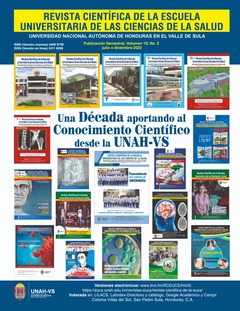Prevalence and risk Factors of hip developmental Dysplasia in newborn in 2 Sampedran Hospitals
DOI:
https://doi.org/10.5377/rceucs.v10i2.18053Keywords:
risk factors, hip dislocation congenital, infant newbornAbstract
Hip dysplasia in development is an alteration in the development and anatomical relationship of the components of the coxofemoral joint that includes the iliac bone, femur, joint capsule, ligaments and muscles. It may be secondary to intrinsic and/or extrinsic causes, which determine an abnormal relationship between the femoral head and the acetabulum. The objective: to determine the prevalence and risk factors of developing hip dysplasia (DCD) in newborns from Hospitals Mario Catarino Rivas (HMCR) and Leonardo Martínez Valenzuela (HLMV), july 2018 to june 2019. Patients and methods: Prospective study, observational-analytical. Universe; newborns from both hospitals. Sample 167 newborns (NB), convenience sampling. Healthy neonates were included, whose parents provided informed consent. Data collection through a survey-type questionnaire that contained 22 closed questions addressed to the mother and data from the newborn, obtained through review of the clinical record: Barlow and Ortolani maneuvers and the AP X-ray image study of the hip by which the Acetabular Index and Concentric Centration of Fernández were determined. Data analysis was carried out in the EPI Info program version 7.2.2.16. Prevalence, Relative Risk and Confidence Interval were calculated. Tables and graphs were made in Microsoft Excel 2017. Results: DCD was diagnosed in 17 neonates (prevalence 10.18%). Of which; 13 (76.47%) were female, 15 (88.24%) had negative Ortolani and Barlow maneuvers and 9 (53%) had bilateral DCD. The risk factors found were: children of primigravida mothers RR: 2.61 (CI:0.96;7.08), 24 years or younger RR: 3.58 (CI:0.85;15.12), with oligohydramnios RR: 2.55 (CI:0.44;14.8 ). As for the RNs; female sex RR 3.37 (CI:1.15;9.91), pelvic presentation RR 4.9 (CI2.02;11.62), and with a family history of DCD: RR 2.55 (CI:0.44;14.80). Multiple pregnancy turned out to be a protective factor RR 0.00 (CI:0.07;0.75). Conclusion: DCD occurred in approximately one in ten newborns. Among the main risk factors were: children of first-time mothers, 24 years of age or younger with oligohydramnios, in addition; female newborns, pelvic presentation, and with a family history of DCD. Multiple pregnancy turned out to be a protective factor.
Downloads
584




